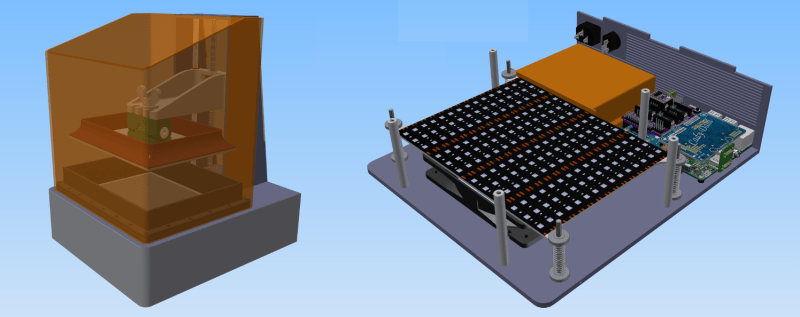Resin-based SLA 3D printers are seen more and more nowadays but remain relatively uncommon. This Low Cost, Open Source, LCD based SLA 3D Printer design by [Dylan Reynolds] is a concept that aims to make DIY SLA 3D printing more accessible. The idea is to use hardware and manufacturing methods that are more readily available to hobbyists to create a reliable and consistent DIY platform.
[Dylan]’s goal isn’t really to compete with any of the hobbyist or prosumer options on the market; it’s more a test bed for himself and others, to show that a low-cost design that takes full advantage of modern hardware like the Raspberry Pi can be made. The result would be a hackable platform to let people more easily develop, experiment, or simply tamper with whatever part or parts they wish.




















I was under the impression that LCD panels are normally destroyed by UV light and that they have UV filters. Unless perhaps I’m missing something
You’re not.
They will let through like 1% UV, so if you blast enough through them and treat them as a consumable…
It looks like using 400nm or above such as 410nm UV led’s would be one way around it
http://www.buildyourownsla.com/forum/viewtopic.php?t=84&start=20
Since there’s no separate UV filter, instead it’s the polarisers that cause the problem
That being said it’d be interesting to see how long the LCD’s last
Use an LCD from a popular smartphone. at $30, it’s a consumable.
HaD prize “build something that matters”: Trash, Benchoff, trash…
Not read the rules of the HaD prize, but playing devils advocate nonetheless;
I’d view Brian’s approach as acceptable during prototyping phase… if it looks viable to go to production, you’d likely consider a custom part without the polarizers, and UV, as mentioned by garlicbeardy a few posts up.
But also, as much as I don’t condone it, no matter how many screens are used by even the largest realistic user base for this printer, such a number would fall below the observable limits when compared to the number of screens coming from actual phones.
https://web.wpi.edu/Pubs/E-project/Available/E-project-043009-162846/unrestricted/FinalMQP.pdf
There appears to be the idea of using inkjet technology as well.
Hmm good project bit should have chosen an epson as thier print heads are driven by piezo elements and would much better for fluids such as uv polymers.
I wonder if there are any two-part resins that cold be loaded into two different color cartridges and combined on the substrate by activating both jets for that dot location or by making two passes,one in part A and one in part B. Acrylic usually has a powder and a liquid component, does anyone know of a plastic resin with two liquid components?
Nice project. But there is one huge drawback in SLA technology. Galvanometer driven UV Laser curing is also low cost solution. Even factory build Wanhao SLA printer is not very expencive too (sligthly higher price than FDM). But the price of UV curing resin usable for SLA printing make all this efforts to build low cost SLA printer completely doomed. And it’s not even like 2D inkjet printers, where manufacturer makes money on cartriges with cheap ink inside. Here the “ink” itself is too expencive.
So you’re saying he hasn’t actually built this yet?